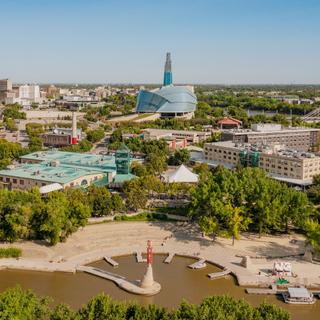


Winnipeg, winning the Canadian West once more
FeatureAfter the golden age of the early 20th century reflected in its magnificent Art Nouveau skyscrapers, Manitoba's capital is now returning to its indigenous roots and cosmopolitan identity, notably through the Canadian Museum for Human Rights.
The clamor of wheat traders died down long ago. Once lured by the promise of jobs or new farmland given by the Canadian government for a few dollars, the hustle and bustle of immigrant families from all over Europe and Eastern Canada is a thing of the past. A sepulchral silence reigns in Union Station, Winnipeg's train station, now open only a few hours a week for the arrival and departure of the rare trains making up the Toronto-Vancouver line. Yet beneath the blue and gold vaulted ceiling of the huge and now deserted concourse, you can still imagine hearing the hubbub of the pioneers who made this small Manitoba city the beating heart of the Canadian West until the early 20th century.
"Before the First World War, Winnipeg was so dynamic that it was nicknamed the Chicago of the North," said Susan Ainley, communications manager for the city's tourism organization. Union Station, constructed by the architectural firm Warren and Wetmore in 1911, mirrors the design of New York's Grand Central Station. It served as the endpoint for three railroad companies crucial to the nation's industrial growth and westward expansion. Situated midway between the Atlantic and Pacific oceans, in the heart of the Prairies – Canada's breadbasket – Winnipeg became the country's leading grain market and one of its main manufacturing centers in just a few decades. Its population quintupled between 1881 and 1911.
A stroll around the station reveals the architectural traces of this golden age. In the château style, inspired by the French Renaissance, the imposing Hôtel Fort Garry (the town's original name) is one of a series of establishments built by railway companies to provide luxurious accommodations for their passengers. Topped with turrets like the Hôtel Le Château Frontenac overlooking St. Lawrence in Quebec City, it retains the old-fashioned, ostentatious charm of the time, available to women dressed in heavy beaver-fur coats, accompanying husbands who had come to make their fortune in the "young" country that was then Canada.

A few hundred meters to the north, scattered throughout the Exchange District around the Grain Exchange built in 1906, lie the first steel-framed, curtain-wall skyscrapers. These 10-story buildings, decorated in the Art Nouveau style of the so-called "Chicago School," are still among the finest in North America. It's not unusual for the hustle and bustle of the old downtown area to be put on hold for a few hours to make way for film shoots eager to recapture the atmosphere of the Belle Epoque.
You have 65% of this article left to read. The rest is for subscribers only.
